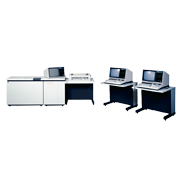Following the HAYAC-5000, Sharp launched the HAYAC-6000 in May 1978. Running on bipolar four-bit slice processors, the HAYAC-6000 was the first chained-processor office computer that could link multiple computers. It could also process kanji characters.
The model's primary features were as follows:
- (1)The chained-processor architecture, which could interconnect up to six computers, simplified system expansion and made it possible to process large amounts of data at high speeds. This architecture had its own shared memory separate from the memory of each computer, and this shared memory was used to pass and sync data between computers.
- (2)The HAYAC-6000's multi-work function, which allowed it to parallel process eight different tasks at the same time on up to 64 terminals, made it possible to scale up to much larger systems.
- (3)Many of its features had been improved from the HAYAC-5000, including the implementation of virtual memory, improved communication functions, larger file capacity, and swappable cartridge disk files.
- (4)The HAYAC-6000 was developed with priority on real-world usability and so it included a large display for easier dialog-based operations and an input sensor panel for codeless inputs that didn't require specially trained operators.
- (5)Sharp made giant leaps forward on the software side as well, including the development of APPLES, a parameter-based high-level language that anyone could use.
- (6)The HAYAC-6000 could be used as an inline system for billing, data entry, or various inquiries or as a versatile data processing or data communications system when combined with a large-capacity disk unit or high-speed printer.


